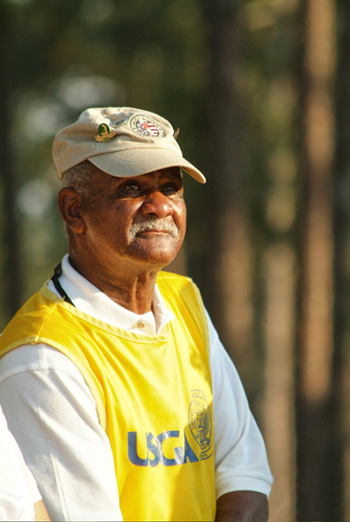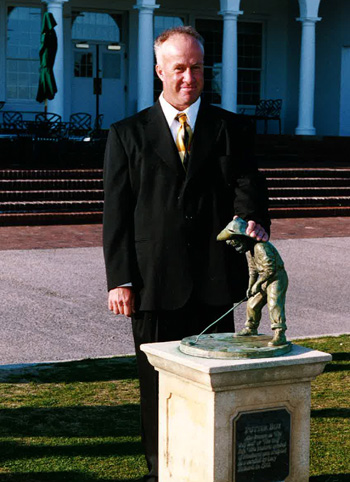African American caddies (men, women, boys and girls) have been part of the life and landscape of Pinehurst for 118 years, starting when 9 holes of golf were established in 1898, growing to 18 holes one year later. Jim Crow fostered it and the advent of Civil Rights saw it change to what it is today. As the former historian of the Pinehurst Golf and Country Club, I’d like the significant contributions to the game of golf by all caddies more fully recognized.
In 2001, Don Padgett, Pat Corso and Mike Granuzzo, owner of Caddiemaster, Inc., created the Pinehurst Caddie Hall of Fame with nine famous black and one white caddie inducted and honored at a formal dinner. The nominees were, “All outstanding citizens of the community and long-term contributors to Pinehurst’s caddie program.” The Hall of Fame was a good beginning, but no other caddie has been so honored in the past 15 years. It is high time to continue that noble tradition.
In 1933, Pinehurst Caddy Master Donald A. Currie reported that 550 caddies had been employed in the ’20s. Even during the Great Depression, Pinehurst engaged 190 caddies. Currie said, “They went out twice a day, with some carrying two bags. On good days they made $3.00 plus tips, but the average was between 75 cents and a dollar daily.” Caddies were fed palatable food at a minimum cost. They were examined, vaccinated, given medical treatment annually and checked for contagious diseases. Currie reported some pretty big names on the caddy roster, including, “George Washington, Abraham Lincoln, William McKinley, Martin Luther, Teddy Roosevelt, William H. Taft, Thomas Jefferson and Jesse James.”
Currie said they, “Banked their earnings in the local savings bank, but that many gambled, often betting 50 cents a hole, while the golfers might be betting only 10 cents a hole.” An important date was January 1, 1939, when the U.S. Golf Association ruled that not over 14 clubs were to be in a bag. Before then a golfer might carry 20 clubs, or more. It was a happy day for caddies, particularly the younger small ones.
The arrival of the golf cart hastened the end of caddying at most American golf courses. Carts were first tested here in 1947, becoming popular in the fifties. The tradition of providing top notch caddies to Pinehurst members and guests has remained in place. They are always available on Course No. 2, and can be reserved for the other courses.
The 2001 Hall of Fame black inductees were Fletcher Gaines, Robert “Hardrock” Robinson, Jimmy Steed, Teddy Marley, Robert Stafford, Hilton “Doctor” Rodgers, John T. “Barney Google” Daniel, Jack “Caddie Master” Williams, and Willie McRae. Jeff Ferguson is the lone Caucasian.
 Only two of the honorees are alive, and remarkably both are still caddying.
Only two of the honorees are alive, and remarkably both are still caddying.
Photo: Willie McRae, Courtesy of Tufts Archives and Donald McKenzie
Willie McRae, began his profession at age 10, in 1943, and still serves golfers, albeit he’s allowed to ride a cart on Course No. 2, the only person permitted to do so. Willie was enlisted in the 1951 Ryder Cup Matches for European team member, Fred Daley and was on the bag for North & South winner Gary Cowan in 1970.
Jeff Ferguson began his career in 1976 at age 17. Jeff helped Davis Love III win the 1984 North & South Amateur, joining the winners in an unprecedented 12 North & South Championships. He served in the 1994 U.S. Senior Open, the 1999 and 2005 U.S. Opens, and the 2015 Women’s U.S. Open.
 Fletcher Gaines, starting in 1938 served for 57 years and was an accomplished golfer in his own right winning seven consecutive Caddie Championships and 10 victories overall.
Fletcher Gaines, starting in 1938 served for 57 years and was an accomplished golfer in his own right winning seven consecutive Caddie Championships and 10 victories overall.
Photo: Jeff Ferguson, Courtesy of Tufts Archives and Donald McKenzie
He carried Curtis Strange for back-to-back North & South championship wins in 1975 and 1976. “Hardrock” Robinson started in the mid-’20s and was famous for his tap dancing ability as a member of the original caddie band. He once carded a 64 on No. 1, and was featured in the 1927 film, “The Sun Sets In Pinehurst,” staring Gloria Swanson.
Jimmy Steed, who caddied for 30 years, was Sam Snead’s favorite caddie. He scored a hole-in-one in a Caddie Championship. Ted Marley, who first caddied here in 1937, gave Pinehurst 25 years of dedicated service before retiring in 2000. He caddied for Payne Stewart prior to the 1999 U.S. Open Championship. Robert Stafford started in 1934 and caddied for golf legends like Donald Ross and Sam Snead.
He retired in 2000 after 66 years, winning thousands of friends for Pinehurst. Hilton Rodgers began carrying in 1950, and gave Pinehurst 51 years of masterful caddying. Legend has it that he could read a putt from inside the clubhouse. John Daniel helped the remarkable Harvie Ward win the 1948 North & South Championship by one-putting 18 times over 36 holes to beat Frank Stranahan. Jack Williams was a congenial Caddie Master who died on duty during the final round of the 1955 North & South.
Richard Mandell, a prominent golf course architect has written, “Caddying to me provides so much to the experience of a golf round, especially at Pinehurst. Not just the aura that it creates but the ability to walk alongside someone with intimate knowledge of the golf course is so much better for one’s game than riding in a golf cart.”
At Pinehurst Country Club there are life-size bronze statues of famed course architect Donald Ross, former club president Richard Tufts, U.S. Open champion Payne Stewart, and late resort owner, Robert Dedman, Sr. looking over Course No. 2, its premier course. I’d like to see the resort and club members erect another bronze, this time to honor the thousands of dedicated caddies, black and white, men and women who’ve heightened the pleasures of the sport of golf here.
For golfers who would like to experience what it is like to play No. 2 with Willie McRae and Jeff Ferguson, please know that you can still do so.
 Paul R. Dunn, author of Great Donald Ross Golf Courses You Can Play, lives in Pinehurst.
Paul R. Dunn, author of Great Donald Ross Golf Courses You Can Play, lives in Pinehurst.
Pictured with statues of Golf Course Architect Donald Ross (left), and Richard Tufts (right), operator of Pinehurst Resorts.


